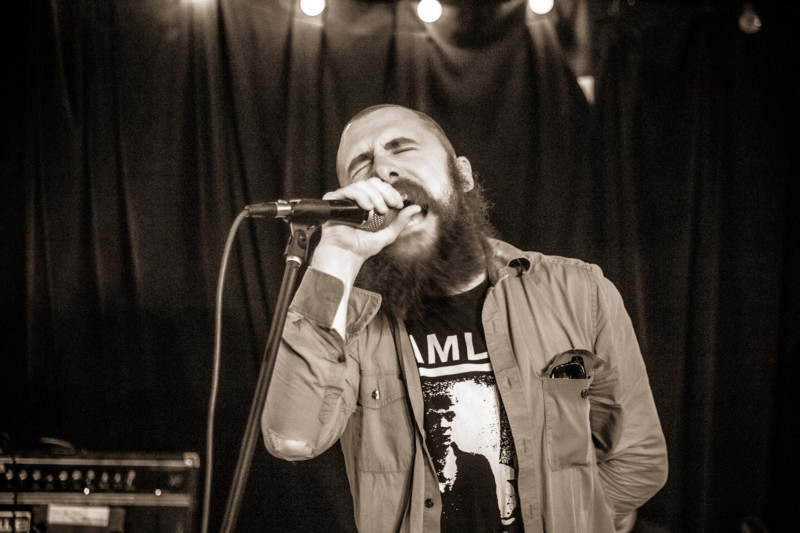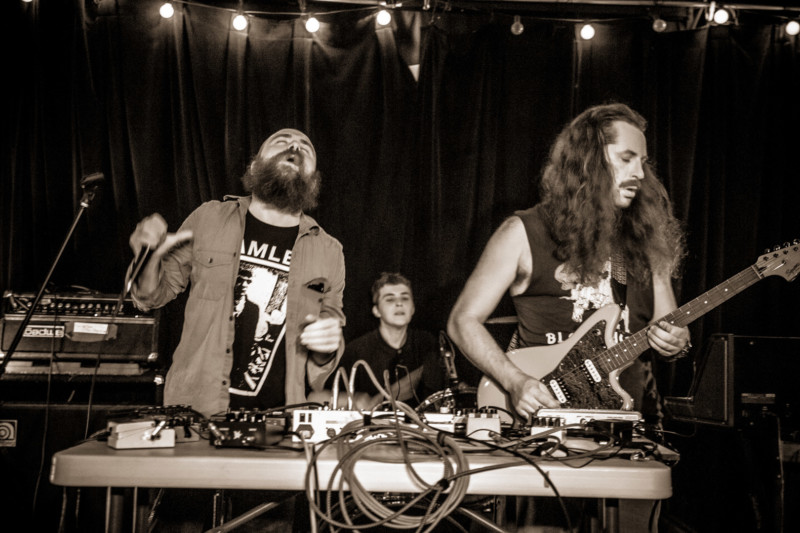Thoughtful writer Joshua Poveda gives his take on Opening Bell and asks Mr. Mike some questions.
Find it here or scroll down…
The band will be heading up to New England this weekend for the following dates:
December 29 Boston, Massachusetts @ Great Scott w/ Animal Hospital + guests
December 30 Portland, Maine @ Geno’s w/ Nycterent + guests
Opening Bell, a trio based out of New York City, creates contemplative sonic environments wherein the band addresses, in my opinion——and to their credit, with ample grace——the gracelessness of humanity. Rhythmic efficiency, impressionistic electronic melodies, mixed with black metal’s pathological aesthetic creates a sound that blossoms and persists without a single musical statement going adrift. They aren’t doom-metal tight, but have enough grease and swing to give their haunting synth tones enough puff to stand out like purple in a red sunset. If anything, they are closer to atmospheric black metal, minus the mascara, with electronic synthesizers and a keen sensibility for poetics.
It’s bands like Opening Bell that remind me of contemporary music’s potential to evolve beyond category. I’m under the impression that alchemy shouldn’t be used as some container concept for New School kids with pink hair showing the world how far they can push their ideological zeal. Alchemy should be reserved for this very real transformation of essence, in this case, sound into new structures of communication. From what I gather, Opening Bell’s music mirrors the narrative structure of our dreams. You know, that dark stuff that flirts with chaos and disaster, that headspace of infinity, where answers and questions become one and you can never anticipate what’ll happen next. There’s a reason for that. It’s because the dreaming mind is constantly shifting its attention. Not unlike google brain’s psychedelic artwork, in dreams we constantly attempt to fill in voids with rational concepts, desires, fears, and phenomena, no matter the source.
This brings me to the first time I saw Opening Bell: I stood in a leaky sonic envelope, feeling a big push of air against my body, surrounded by buzzing frequencies as a writhing voice escaped with hot distortion. There was a foundational logic for each melodic phrase, including a rich diversity of timbre, which assisted the development of a collective harmony across fuzzed out pads and riffs, vocals, and drums. An ever-so-subtle swing in the beat cut high across all frequencies, pushing time forward with a bold foot. As the space of each song grew larger and larger, I pictured a hand slowly tearing away layers of old wallpaper, revealing the strange ruins of a past life. It was an illustration of how secrets, often passively, become the source of our inner demons. Therefore, and at least for my listening pleasure, Opening Bell’s lyrical atmospheres created a space for reconciling the ambivalence of the dream, where one can find their deepest secrets, with reality. I was at once immersed in the narrative of my own psychology, making meaning out of chaos, realizing that the sublime can be served up in many ways, and that grace is best reserved for those who consider themselves superhuman.
I’ve clearly expressed my own take on the music, so I was eager to ask Mike Thomas Reisinger from Opening Bell and founder of independent label Sleeping Giant Glossolalia a few questions.
So, during your set I got the impression of it having a narrative structure. There was cohesion, and each song seemed to flow together seamlessly whilst remaining independent. Is there conscious effort to achieve this? Does narrative play into your design of a setlist at all?
Yes, the live set functioning with a narrative structure is intentional. The songs from that set are taken from two separate EPs(one that just came out and another that will be released in the near future) recorded at different times and in different places. While the subject matter varies from song to song, I think we are able to present them live as though they belong together, at least sonically. For instance, giving some of the electronic textures similar treatments at the beginning and end of the set make it feel like one cohesive piece of music. The segues also act as a way to quickly catch some breath between songs…
And what kind of subject matter is each EP dealing with? Does each EP revolve around a theme, or do songs deal with them independently?
Now that I’m forced to really think about it, I guess there is a common theme of survival among the songs, or something like that. But each one in a different way. “Loma Atomal” for instance, is about my friend Nevada Hill, who fought incredibly hard against cancer and displayed a kind of courage and determination I couldn’t even imagine until it ultimately took his life. “Compound Eyes” is a little more broad, abstract, and paranoid, if I’m being honest.
Tell me more about Sleeping Giant Glossolalia. What is it? Where does the name come from?
Sleeping Giant Glossolalia is a record label I started several years ago in order to release whatever weird music my friends and I were making, and I suppose that’s essentially what it still is, though on a larger scale. The name comes from some lyrics from an old band of mine; something about veiled threats and potential upheaval, compulsion to behave in ways that seem counterintuitive, and speaking in tongues. Yeah, if I ever considered it was going to become an actual “business,” responsible for some of my favorite recordings, I might not have given it such a convoluted, difficult to pronounce and remember name. Luckily, “SGG Records” rolls off the tongue and is sympathetic to search engines.
I see you have post-industrial listed as a genre on your band camp. What exactly makes your sound characteristic of post-industrial?
I have no idea what “post-industrial” is supposed to be, but I guess that tag is more acceptable to people than the made-up genres like “bunkerbeat” I was using. The unconventional use of electronics ties it to industrial, maybe, and the “post” because it obviously isn’t purely that style, or any style, really.
I was impressed by the balance between Opening Bell’s sonic elements: Wet vocals, fuzz, synth-bass, and of course the live drum kit. Did this balance have to evolve over time or was it an effort from the get-go.
It did develop over time, yeah. Initially, Armando and I were making largely improvisational electronic music, but that kind of evolved into a few different projects. We added guitar and live drums to Opening Bell and started writing actual songs, and eventually Nellie joined the group as a permanent drummer and that solidified things. It has managed to retain a similar “bad feeling” from the onset, though.
If you could add any element to your live shows (I.e., architecture, video projection, performance art, etc.,) what would it be and why?
Hmm, tough one. We have used video projections to some extent but it’s kind of hard to pull off in a unique way. Without asking my bandmates to chime in, I’m going to go ahead and say it would be cool to incorporate some kind of interpretive dance, though I can’t imagine that working well. Who would dance to this stuff? Wait, no. Puppetry! My answer is puppets.
photos by Cory Goldberg


